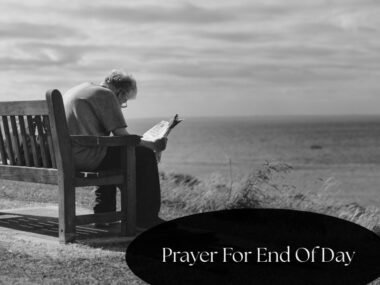You’ve probably heard it in church meetings, recovery groups, or even printed on a mug: “God, grant me the serenity…” It’s calming. It’s wise. And it sounds like something plucked straight from the pages of Scripture. But if you’ve ever flipped through the Bible trying to find where exactly the Serenity Prayer is written, you may have come up empty. Don’t worry—you’re not alone. Many believers assume it’s in the book of Psalms or Proverbs because of how rich it sounds in spiritual depth.
The truth? The Serenity Prayer is not a Bible verse. But before you toss that mug or scroll away disappointed, stick around. While it isn’t directly quoted in Scripture, its themes—peace, courage, and wisdom—are deeply rooted in the heart of the Bible. In this article, we’ll explore the topic, Where Can I Find The Serenity Prayer In The Bible? and know where the prayer comes from, why it resonates so strongly with biblical truths, and how you can pair it with Scripture for your spiritual journey.
What Is the Serenity Prayer?
The Serenity Prayer is a simple but powerful petition that calls on God for peace, strength, and discernment. The most commonly quoted version is:
“God, grant me the serenity to accept the things I cannot change,
Courage to change the things I can,
And wisdom to know the difference.”
There’s also an extended version, often used in spiritual and recovery settings, that continues with a deeper call to living a Christ-centered life, embracing hardship, and trusting in divine will. While it feels like a biblical psalm or proverb, the prayer was actually written by Reinhold Niebuhr, a 20th-century American theologian and ethicist. He first penned it in the 1930s, and it gained widespread use among groups like Alcoholics Anonymous (AA), who adopted it as a spiritual tool for surrender and healing.
Its simplicity is part of its power. Each line is a reflection of our deep spiritual needs—peace in chaos, courage in uncertainty, and wisdom when faced with life’s blurry lines. Though not from the Bible itself, this prayer echoes many biblical ideas, making it a beloved tool for spiritual growth.
Is the Serenity Prayer in the Bible?
Let’s be clear: the Serenity Prayer is not found word-for-word anywhere in the Bible. You won’t find it tucked into Psalms, embedded in Paul’s letters, or nestled between Proverbs. But that doesn’t mean it’s unbiblical. Quite the opposite, actually. The prayer’s structure and content draw heavily from scriptural ideas that echo throughout the Old and New Testaments.
So why do many people assume it’s from the Bible? Because it sounds biblical. The phrasing, the appeal to God, the themes of surrender and trust—these are all deeply embedded in the Christian tradition. Much like hymns or creeds, the Serenity Prayer carries a theological richness that mirrors Scripture, even if it’s not part of it.
The Bible may not contain the Serenity Prayer verbatim, but it certainly contains its message. It’s a distilled form of biblical wisdom, and that’s part of why it remains timeless and relevant. In the next sections, we’ll break down how each line of the prayer reflects specific passages and principles from the Word of God.
Biblical Themes Reflected in the Serenity Prayer
The Serenity Prayer may not be scripture, but it is soaked in scriptural wisdom. Let’s explore how each part of the prayer reflects biblical truth.
“God, grant me the serenity to accept the things I cannot change” points us toward peace and surrender. Philippians 4:6–7 says, “Do not be anxious about anything, but in every situation… present your requests to God. And the peace of God… will guard your hearts.” This is serenity—God’s supernatural calm in life’s storms. Similarly, John 14:27 reminds us, “Peace I leave with you; my peace I give you. Do not let your hearts be troubled…” That divine peace is exactly what the prayer seeks: serenity when life throws curveballs we can’t control.
“Courage to change the things I can” echoes Scripture’s call to bravery and action. In Joshua 1:9, God commands, “Be strong and courageous. Do not be afraid… for the Lord your God is with you.” And 2 Timothy 1:7 affirms, “God has not given us a spirit of fear, but of power, love, and self-discipline.” God calls His children to be agents of change—led not by fear but by faith.
“And wisdom to know the difference” is the final—and arguably most difficult—petition. Discernment is a prized gift in the Bible. James 1:5 promises, “If any of you lacks wisdom, you should ask God… and it will be given to you.” And Proverbs 3:5–6 gives the secret: “Trust in the Lord with all your heart… and he will make your paths straight.” Wisdom is knowing when to act, when to wait, and when to let go—and God freely offers it to those who ask.
Why the Serenity Prayer Still Holds Biblical Value
Although not part of the canon of Scripture, the Serenity Prayer is undeniably soaked in biblical spirit. Its lines resonate because they reflect what God wants for us: peace in our hearts, courage in our walk, and wisdom in our minds. It encourages us to lay down anxiety and cling to trust. This is what much of biblical living is about—living humbly, acting boldly, and relying wholly on God.
Its simplicity is also its power. Like the Lord’s Prayer or Psalms, the Serenity Prayer speaks to the soul with clarity and comfort. It doesn’t replace Scripture, but it complements it beautifully. That’s why so many believers, ministries, and recovery groups find themselves anchored in its truth. The prayer acts like a bridge between the Word of God and the everyday struggles we face—it points us upward when life pulls us down.
How to Use the Serenity Prayer with Scripture
The Serenity Prayer can be a powerful spiritual tool when paired intentionally with God’s Word. Instead of reciting it in isolation, try turning each line into a personalized conversation with God, supported by scripture. This way, it becomes not just a calming mantra, but a biblically grounded declaration of faith.
For example, when you say, “God, grant me the serenity to accept the things I cannot change,” follow it by meditating on John 14:27 or Philippians 4:6–7. Let God’s promises of peace sink deep into your heart. You might even say, “Lord, just like You said in Your Word that Your peace guards my heart, let me live in that truth today.”
Similarly, with “courage to change the things I can,” pair it with Joshua 1:9 or 2 Timothy 1:7, and pray, “Father, Your Word tells me I do not walk in fear but in power. Give me the courage to speak, act, and lead as You call me.”
Lastly, “and the wisdom to know the difference” can be prayed alongside James 1:5 and Proverbs 3:5–6. Ask, “Lord, I’m confused. But You promised to give wisdom generously. Help me trust and wait for Your direction.”
You can even structure a weeklong devotional using the prayer—dedicating one or two days to each line, studying related scriptures, and journaling how God speaks through them. Used this way, the Serenity Prayer doesn’t just encourage reflection; it becomes a doorway to deeper communion with the Living Word.
Other Bible Verses That Echo the Serenity Prayer’s Message
Though the prayer isn’t in the Bible word-for-word, there are many verses that carry its spirit. These scriptures can serve as alternatives or complements when praying for peace, courage, and wisdom.
Psalm 46:10 – “Be still, and know that I am God…”
This verse embodies serenity. It’s an invitation to quiet the noise of life and trust in God’s sovereignty.
Romans 12:2 – “Do not conform to the pattern of this world, but be transformed by the renewing of your mind…”
This connects to wisdom. Transformation starts when we surrender to God’s perspective and let Him shape our decisions.
Ecclesiastes 3:1 – “There is a time for everything, and a season for every activity under the heavens…”
This captures the balance the Serenity Prayer reflects—the wisdom to accept when change is out of our hands and the courage to act when it’s time to move.
Each of these verses can be personalized and used in your daily prayer time. You might even find new favorite scriptures as you reflect on what serenity, courage, and wisdom mean in your life. The key is recognizing that while the prayer may not come directly from Scripture, it deeply aligns with the heart of God’s message.
Conclusion
The Serenity Prayer may not be found in the pages of the Bible, but its heart certainly beats with biblical truth. Written by theologian Reinhold Niebuhr, its lines echo the themes of peace, strength, and discernment found throughout Scripture. It’s not the presence of chapter and verse that gives a prayer value—it’s the alignment with God’s Word and His will. The Serenity Prayer beautifully captures what we so often need in a chaotic world: a reminder to trust God with what we cannot control, act boldly where we can, and seek His wisdom every step of the way.
Rather than wondering where it’s written, we can embrace the spirit of the prayer by anchoring it in Scripture, meditating on God’s promises, and living it out in faith. Whether you’re walking through grief, recovery, decision-making, or just daily life, the Serenity Prayer can serve as a faithful companion. And as you speak it with intention, backed by the unshakable Word of God, it becomes more than a quote—it becomes a lifestyle of spiritual surrender and strength.







